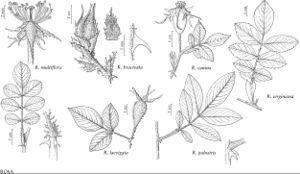Difference between revisions of "Rosa laevigata"
Fl. Bor.-Amer. 1: 295. 1803.
FNA>Volume Importer |
FNA>Volume Importer |
||
| Line 10: | Line 10: | ||
|special_status={{Treatment/ID/Special_status | |special_status={{Treatment/ID/Special_status | ||
|code=F | |code=F | ||
| − | |label= | + | |label=Illustrated |
}}{{Treatment/ID/Special_status | }}{{Treatment/ID/Special_status | ||
|code=I | |code=I | ||
| Line 19: | Line 19: | ||
|name=Rosa cherokeensis | |name=Rosa cherokeensis | ||
|authority=Donn ex Small | |authority=Donn ex Small | ||
| + | |rank=species | ||
}} | }} | ||
|hierarchy=Rosaceae;Rosaceae subfam. Rosoideae;Rosaceae tribe Roseae;Rosa;Rosa subg. Rosa;Rosa sect. Laevigatae;Rosa laevigata | |hierarchy=Rosaceae;Rosaceae subfam. Rosoideae;Rosaceae tribe Roseae;Rosa;Rosa subg. Rosa;Rosa sect. Laevigatae;Rosa laevigata | ||
| Line 44: | Line 45: | ||
-->{{#Taxon: | -->{{#Taxon: | ||
name=Rosa laevigata | name=Rosa laevigata | ||
| − | |||
|authority=Michaux | |authority=Michaux | ||
|rank=species | |rank=species | ||
| Line 59: | Line 59: | ||
|publication title=Fl. Bor.-Amer. | |publication title=Fl. Bor.-Amer. | ||
|publication year=1803 | |publication year=1803 | ||
| − | |special status= | + | |special status=Illustrated;Introduced |
| − | |source xml=https://jpend@bitbucket.org/aafc-mbb/fna-data-curation.git/src/ | + | |source xml=https://jpend@bitbucket.org/aafc-mbb/fna-data-curation.git/src/f50eec43f223ca0e34566be0b046453a0960e173/coarse_grained_fna_xml/V9/V9_128.xml |
|subfamily=Rosaceae subfam. Rosoideae | |subfamily=Rosaceae subfam. Rosoideae | ||
|tribe=Rosaceae tribe Roseae | |tribe=Rosaceae tribe Roseae | ||
Revision as of 22:38, 16 December 2019
Stems: distal branches dark brown to purplish red; infrastipular prickles paired, internodal prickles paired or single, reddish brown, rarely deltate or erect, 6–9 × 6–11 mm. Leaves: stipules 4–6 × 1–2 mm, auricles 5–7(–10) mm, surfaces glabrous; petiole and rachis sometimes with pricklets, glabrous, eglandular; leaflets: terminal larger than laterals, base cuneate, margins 1-serrate, teeth 20–30 per side, tipped with dark glands, apex acute or acuminate, abaxial surfaces usually with pricklets on midveins. Pedicels densely setose; bracts attached near base, lanceolate, 5 × 2–3 mm, margins not ciliate, surfaces glabrous, eglandular. Flowers 1(or 2); hypanthium 5–9 × 4–6 mm, densely setose, setae 2–3 mm, some gland-tipped; sepal tip 5–10 × 2 mm; petals 25–35 × 25–30 mm; styles exsert 1–2 mm beyond hypanthium orifice. Hips leathery, base elongate, 7–12 mm, neck 1–2 × 6–9 mm. Achenes 20–30, light tan, 6–8 × 3–4 mm. 2n = 14.
Phenology: Flowering (Feb–)Apr–Jun.
Habitat: Swamp edges, pastures, fence and hedge rows, abandoned fields, roadsides, pine barrens, disturbed areas
Elevation: 0–500 m
Distribution

Ala., Fla., Ga., La., Miss., N.C., S.C., Tex., Asia, introduced also in West Indies, s Africa, Atlantic Islands (Madeira), Pacific Islands (Hawaii).
Discussion
By the nineteenth century, Rosa laevigata was widely found in the southern United States as a hedging shrub, being commonly distributed by stem cuttings and rhizomes, representing relatively few clones (C. A. Walker 1996; Walker and D. J. Werner 1997). The species was named and described from plants collected in Georgia in the 1790s by A. Michaux, who was unaware that his newly discovered species was native to Asia. This suggests a very old introduction into the United States, where it occurs only in the southeast to eastern Texas and the Carolinas. Shrubs form dense, rhizomatous thickets with stems capable of climbing to 100 dm. Leaves are persistent and leathery with mostly three leaflets and stipules free for most of their lengths, then caducous. Inflorescences consist of one (rarely two) white-petaled flowers and have densely setose hypanthia and hips.
In China, where the species is considered one of the most beautiful and cherished of roses, Rosa laevigata has a long history of use by herbal practitioners to treat bronchitis, dysentery, and urogenital disorders, and to restore hair color (J. A. Duke and E. S. Ayensu 1985, vol. 2).
Selected References
None.
